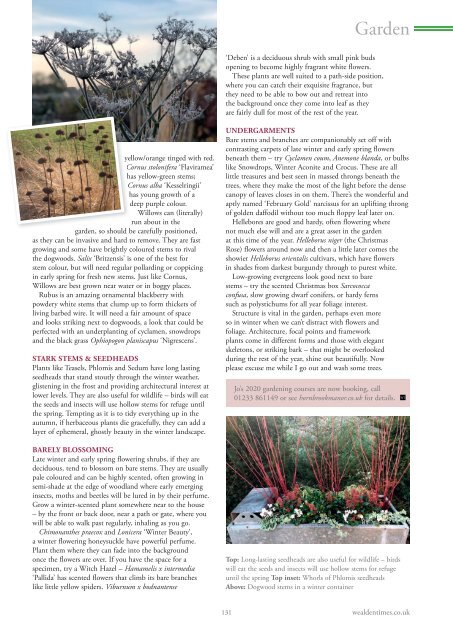Wealden Times | WT216 | February 2020 | Interiors supplement inside
Wealden Times - The lifestyle magazine for the Weald
Wealden Times - The lifestyle magazine for the Weald
You also want an ePaper? Increase the reach of your titles
YUMPU automatically turns print PDFs into web optimized ePapers that Google loves.
Garden<br />
‘Deben’ is a deciduous shrub with small pink buds<br />
opening to become highly fragrant white flowers.<br />
These plants are well suited to a path-side position,<br />
where you can catch their exquisite fragrance, but<br />
they need to be able to bow out and retreat into<br />
the background once they come into leaf as they<br />
are fairly dull for most of the rest of the year.<br />
yellow/orange tinged with red.<br />
Cornus stolonifera ‘Flaviramea’<br />
has yellow-green stems;<br />
Cornus alba ‘Kesselringii’<br />
has young growth of a<br />
deep purple colour.<br />
Willows can (literally)<br />
run about in the<br />
garden, so should be carefully positioned,<br />
as they can be invasive and hard to remove. They are fast<br />
growing and some have brightly coloured stems to rival<br />
the dogwoods. Salix ‘Britzensis’ is one of the best for<br />
stem colour, but will need regular pollarding or coppicing<br />
in early spring for fresh new stems. Just like Cornus,<br />
Willows are best grown near water or in boggy places.<br />
Rubus is an amazing ornamental blackberry with<br />
powdery white stems that clump up to form thickets of<br />
living barbed wire. It will need a fair amount of space<br />
and looks striking next to dogwoods, a look that could be<br />
perfected with an underplanting of cyclamen, snowdrops<br />
and the black grass Ophiopogon planiscapus ‘Nigrescens’.<br />
STARK STEMS & SEEDHEADS<br />
Plants like Teasels, Phlomis and Sedum have long lasting<br />
seedheads that stand stoutly through the winter weather,<br />
glistening in the frost and providing architectural interest at<br />
lower levels. They are also useful for wildlife – birds will eat<br />
the seeds and insects will use hollow stems for refuge until<br />
the spring. Tempting as it is to tidy everything up in the<br />
autumn, if herbaceous plants die gracefully, they can add a<br />
layer of ephemeral, ghostly beauty in the winter landscape.<br />
BARELY BLOSSOMING<br />
Late winter and early spring flowering shrubs, if they are<br />
deciduous, tend to blossom on bare stems. They are usually<br />
pale coloured and can be highly scented, often growing in<br />
semi-shade at the edge of woodland where early emerging<br />
insects, moths and beetles will be lured in by their perfume.<br />
Grow a winter-scented plant somewhere near to the house<br />
– by the front or back door, near a path or gate, where you<br />
will be able to walk past regularly, inhaling as you go.<br />
Chimonanthes praecox and Lonicera ‘Winter Beauty’,<br />
a winter flowering honeysuckle have powerful perfume.<br />
Plant them where they can fade into the background<br />
once the flowers are over. If you have the space for a<br />
specimen, try a Witch Hazel – Hamamelis x intermedia<br />
‘Pallida’ has scented flowers that climb its bare branches<br />
like little yellow spiders. Viburnum x bodnantense<br />
UNDERGARMENTS<br />
Bare stems and branches are companionably set off with<br />
contrasting carpets of late winter and early spring flowers<br />
beneath them – try Cyclamen coum, Anemone blanda, or bulbs<br />
like Snowdrops, Winter Aconite and Crocus. These are all<br />
little treasures and best seen in massed throngs beneath the<br />
trees, where they make the most of the light before the dense<br />
canopy of leaves closes in on them. There’s the wonderful and<br />
aptly named ‘<strong>February</strong> Gold’ narcissus for an uplifting throng<br />
of golden daffodil without too much floppy leaf later on.<br />
Hellebores are good and hardy, often flowering where<br />
not much else will and are a great asset in the garden<br />
at this time of the year. Helleborus niger (the Christmas<br />
Rose) flowers around now and then a little later comes the<br />
showier Helleborus orientalis cultivars, which have flowers<br />
in shades from darkest burgundy through to purest white.<br />
Low-growing evergreens look good next to bare<br />
stems – try the scented Christmas box Sarcococca<br />
confusa, slow growing dwarf conifers, or hardy ferns<br />
such as polystichums for all year foliage interest.<br />
Structure is vital in the garden, perhaps even more<br />
so in winter when we can’t distract with flowers and<br />
foliage. Architecture, focal points and framework<br />
plants come in different forms and those with elegant<br />
skeletons, or striking bark – that might be overlooked<br />
during the rest of the year, shine out beautifully. Now<br />
please excuse me while I go out and wash some trees.<br />
Jo’s <strong>2020</strong> gardening courses are now booking, call<br />
01233 861149 or see hornbrookmanor.co.uk for details.<br />
Top: Long-lasting seedheads are also useful for wildlife – birds<br />
will eat the seeds and insects will use hollow stems for refuge<br />
until the spring Top inset: Whorls of Phlomis seedheads<br />
Above: Dogwood stems in a winter container<br />
131 wealdentimes.co.uk


















